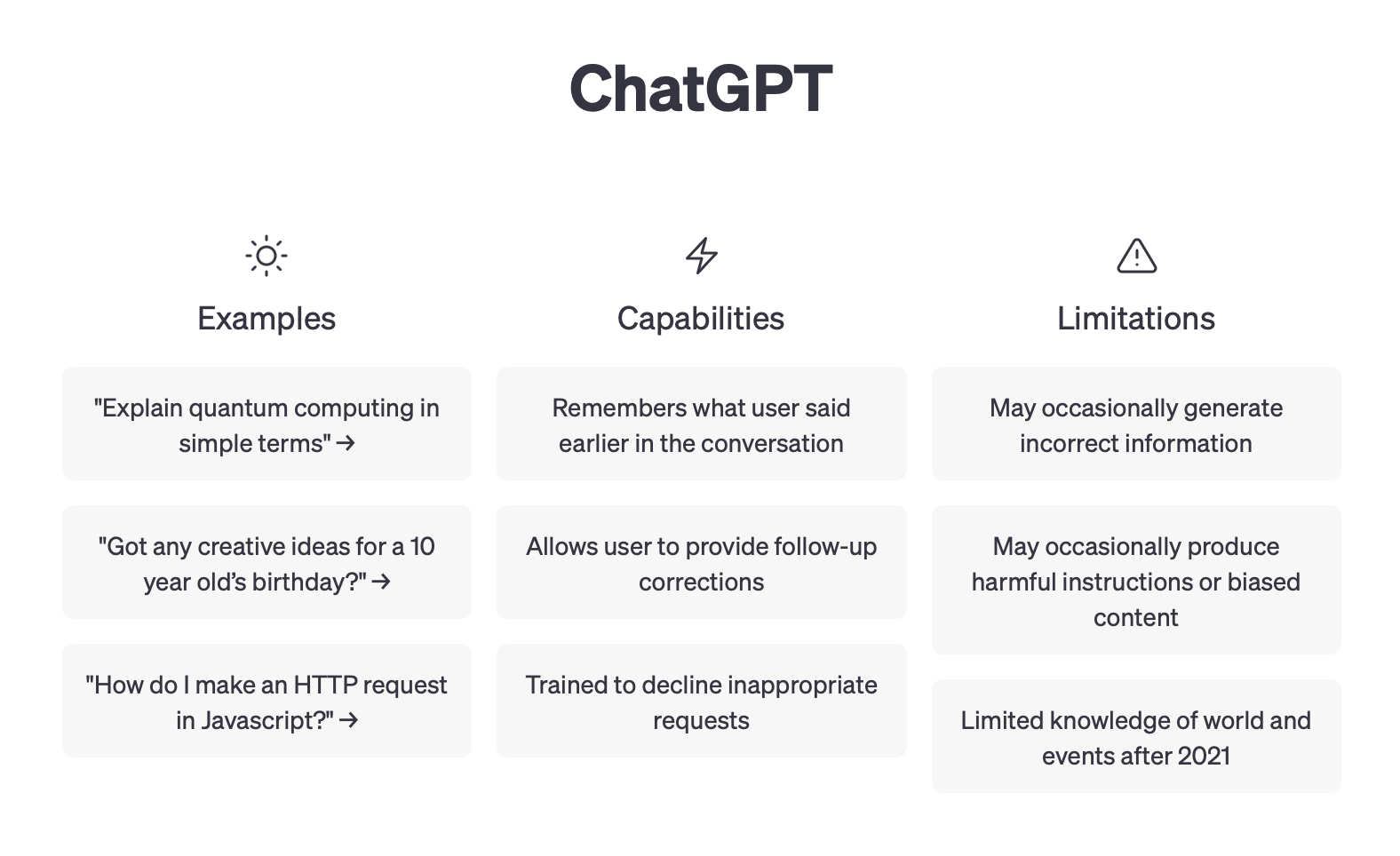What is ChatGPT and how does it work?
ChatGPT is an artificial intelligence (AI) computer program developed by the San Francisco based company,OpenAI. ChatGPT works by taking a natural language input, which is an input of human language as it is spoken and written, from a user and then producing a natural language output. Essentially, ChatGPT works like a search engine (Google, Bing, Yahoo!, etc.). However, instead of returning a list of websites, ChatGPT returns exactly what you ask it to in a conversational format. As a result, ChatGPT enables a user to receive direct responses to their questions. ChatGPT has received substantial media coverage for its easy-to-use interface and extensive capabilities. By simply asking ChatGPT to do so, a user can receive a literary work such as an essay, or an article created by the program.
The natural language outputs that ChatGPT is capable of producing raise the question of whether these outputs are copyright-eligible works. The scope of copyright-eligible works is large because copyright protection can be obtained for any original work of authorship including literary, dramatic, musical, and artistic works. Currently, there are even programs that can produce non-literary works that fall under the dramatic, musical, and artistic work categories. For example, a program named Midjourney can generate images based on a user’s requested criteria and a program by OpenAI named MuseNet can generate musical compositions that sound like a specific artist or genre.
This post will first explain how the United States Copyright Office (“the Copyright Office”) evaluates what works qualify for copyright protection. After explaining the Copyright Office’s policies, the post will explore the IP implications of AI-powered programs like ChatGPT and the copyrightability of works generated by these programs.

What is a copyrightable work?
Under the Copyright Act, a work such as textual material or an image is copyrightable if it is an original work of authorship fixed in any tangible medium of expression. The bar for originality is not high, but short words or phrases are likely not original. Similarly, the term “fixed” can include both tangible mediums, such as paper, and digital mediums, such as a Microsoft Word document. Further, a work must be independently created by the author and possess sufficient creativity to be copyrightable. To be sufficiently creative, a work need not be novel, unique or even good. All that is required is that the work be the product of a minimal creative spark. Most works of authorship therefore meet the creativity requirement.
Works by ChatGPT and similar AI programs can be original, particularly if you ask the program to produce an essay, musical composition, or image that is more than a short word or phrase. Further, works by ChatGPT are fixed in a digital medium because the program produces a text response that can be saved to the user’s online account. In addition, ChatGPT’s natural language outputs can easily be copy/pasted into a Microsoft Word file and saved to a user’s computer. Lastly, ChatGPT and similar AI programs are more than capable of meeting the bar for creativity. Since works created by ChatGPT are original in nature, are fixed in a digital medium, and meet the bar for creativity, the works appear to be copyrightable.
Who owns copyrightable work generated by AI?
Although works generated by artificial intelligence appear to be copyrightable, determining the copyright author when a work is generated at least in part by AI is complicated. In order for a work to be copyrighted, there must be an author to whom copyright ownership is assigned. Is the author the owner of the program, such that OpenAI would own all works created by its product ChatGPT? Or perhaps the owner is each programmer that aided in developing ChatGPT? Or should we ignore the work of the programmers and determine that the author is the user, who by their own manipulation of the existing program was able to generate a certain output? Maybe no human should be the author and credit be given to the AI program?
These are all questions that the Copyright Office has grappled with as AI programs have become more powerful. We are only recently seeing the development of a legal framework surrounding the copyrightability of AI-generated works. The discussion has largely centered on authorship. Just recently, the Copyright Office has provided clarity regarding considerations made by the Copyright Office when determining the author of an AI-generated work.

Can ChatGPT outputs be copyrighted, and if so, by whom?
As ChatGPT suggests (see image below) the answer is complicated. The Copyright Office recently made some clarifications when refusing to grant copyright protection to images generated by the AI program Midjourney, which generates images based on requests by a user.
Kristina Kashtanova attempted to claim copyright protection over images generated by Midjourney on the ground her textual cues followed by a trial-and-error process guided Midjourney to create an image that she had a vison of. The Copyright Office refused to approve Kashtanova’s application for copyright of the images generated by Midjourney.
In a letter explaining this refusal the Copyright Office stated that they “will refuse to register a claim if it determines that a human being did not create the work.” This rule is written in the Compendium of U.S. Copyright Office Practices (Third Edition), which is a manual that explains the many technical requirements, regulations, and legal interpretations of the U.S. Copyright Office. The policies in this manual are followed by copyright examiners — or the agents of the Copyright Office that make determinations on whether something should be granted copyright protection.
As a result of this policy, the Copyright Office will not recognize AI programs like ChatGPT and Midjourney as “authors” for the purpose of copyright protection because these programs are not human beings — even though they write like such!

Since Copyright protection cannot be attributed to the program itself as an entity, the question of whether copyright belongs to the owners of the program or the program developers still remains.
In the letter to Kristina Kashtanova, the Copyright Office also referred to the Supreme Court’s decision in an 1884 case, Burrow-Giles Lithographic Co. v. Sarony, in which the Supreme Court ruled that the “author” of a copyrighted work is the one “who has actually formed the picture.” The Copyright Office explained that when artists such as photographers use editing or other assistive tools, they select what visual material to modify, choose which tools to use and what changes to make, and take specific steps to control the final image such that it amounts to the artist’s “own original mental conception, to which they gave visible form.” According to the Copyright Office, the control that a photographer retains through their creative choices makes a photograph “the product of the photographer’s intellectual invention.” However, in Kashtanova’s case, the Copyright Office did not address whether the owners of the program or the program developers would have sufficient control over the program such that they could be considered authors of the AI-generated work.
However, the Copyright Office clearly stated that “Because of the significant distance between what a user may direct Midjourney to create and the visual material Midjourney actually produces, Midjourney users lack sufficient control over generated images to be treated as the ‘master mind’ behind them.” One way that artists have attempted to exert control over an AI program is by first having a specific mental image of what they want the program’s output to look like. The artist can then subsequently use their understanding of how the program responds to cues and use cues that they believe would result in their vision. Although the cues a user gives may eventually create the artist’s envisioned image, the Copyright Office’s current stance is that there is no guarantee that a particular prompt will generate a particular output. In fact, due to the unpredictability of what the program will generate, the Copyright Office interpreted that any prompts by a user are analogous to giving the program suggestions rather than orders. In other words, the user doesn’t exercise control over the program and a user cannot be granted copyright protection for an image generated by Midjourney.
What does the Copyright Office’s decision imply for ChatGPT?
The Copyright Office’s decision in Kashtanova’s case highlights that the Copyright Office is willing to delve into how different AI programs function and the effects a user has on the program’s output. While this decision does not necessarily prevent a user from being able to get copyright protection over an AI-generated work, it does appear to make the process complicated for the applicant. On March 16, 2023, the Copyright Office made an announcement that they would conduct public listening sessions and gather information during the first half of 2023 to gain a better understanding of current technologies, such as AI, that may impact current copyright policies.
As copyright law continues to develop in this area, it is important to note that other countries have developed bright-line rules. For example, Hong Kong, India, Ireland, New Zealand, and the UK have decided to grant authorship rights to the programmers when determining whether a work is copyrightable. For now, we will have to wait to see if the US follows this approach.

Manuel (Manny) Franco
Associate Blogger
Loyola University Chicago School of Law, J.D. 2024
